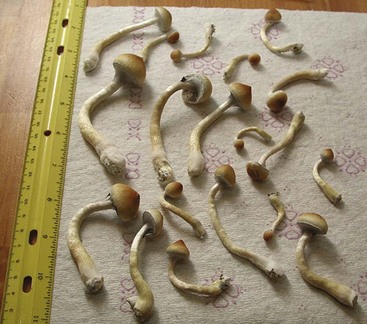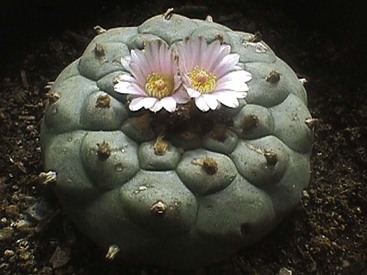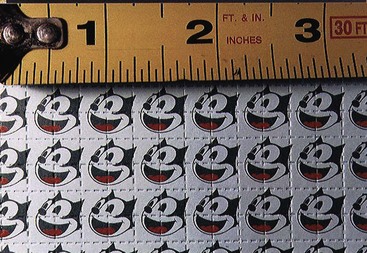Chapter 156 Perspective: Background and Epidemiology Serotonin-like agents are a broad category of compounds that share chemical similarities with serotonin (5-hydroxytryptamine [5-HT]) or enhance serotonergic tone within the body. These agents include various lysergic acid derivatives and tryptamines. Serotonin-like agents produce changes in thought, mood, perception, and consciousness. Orientation to person, place, and time is usually preserved, but severe intoxication may cause confusion. Patients present to the emergency department because of acute panic reactions, massive ingestions, or accidental ingestions (e.g., children or adults who have ingested the drugs unknowingly). There is no addictive component in psychedelics and no euphoria-dysphoria cycle, as with cocaine. The rapid development of tolerance also limits the effect of repeated doses.1 Lysergic acid diethylamide (LSD), or acid, is the most potent psychoactive drug. Doses of 1 to 1.5 µg/kg produce psychedelic effects. The typical dose taken for an acid “trip” is approximately 25 to 100 µg. LSD is sold in tablets (microdots), liquid, powder, gelatin squares (window panes), and “blotter” acid. Sheets of blotting paper are sprayed with LSD, dried, and perforated into small squares. Graphics are incorporated onto the blotting paper in designs that include cartoon characters (e.g., Felix the Cat) and geometric designs (Fig. 156-1). Each sheet is composed of hundreds of squares that are placed sublingually or eaten whole. Massive ingestions are rare. In addition to synthetic LSD, several plants contain alkaloids similar in structure and action to LSD. These plants include Hawaiian baby woodrose (Argyreia nervosa), Hawaiian woodrose (Merremia tuberosa), morning glory (Ipomoea violacea), and oliliuqui (Rivea corymbosa). Intoxication may result after ingestion of the seeds or an extract.2 Psilocybin and psilocin are naturally occurring tryptamines found in some species of Psilocybe (Fig. 156-2), Panaeolus, and Conocybe mushrooms.3 Psilocybin remains active even when the mushrooms are dried or cooked. Street psilocybin sold as pills or capsules is usually substituted with phencyclidine (PCP) or LSD. Misidentification of other poisonous species is a danger of consuming mushrooms. Figure 156-2 Psilocybe cubensis mushroom. (Copyright © 2003 Erowid.org. Accessed at www.erowid.org.) Naturally occurring tryptamines are found not only in plants and fungi but also in the parotid glands of the Bufo toad species. The venom of the Sonoran Desert or Colorado River toad (Bufo alvarius) contains the hallucinogenic substance 5-MeO-DMT, found in the drink ayahuasca. Smoking of the dried venom results in psychoactive effects similar to those of 5-MeO-DMT.4 In addition to the tryptamines that occur in nature, designer tryptamines have been synthesized and are orally active.5 Included in this group are α-methyltryptamine, diisopropyltryptamine, and diisopropyl-5-methoxytryptamine, which is also known on the streets as “foxy” or “foxy methoxy”.6 The effects of these synthetic derivatives are similar to those of naturally occurring tryptamines. Evidence indicates that these drugs act on serotonergic neurons, particularly the 5-HT2A subtype class of serotonin receptors.1,7 The onset of action of the psychoactive effects of LSD is usually within 30 minutes, with peak effects in 3 or 4 hours. The duration of effects may be approximately 12 hours. During the last half of the 12-hour effect, irritability, increased muscle tension (especially in the face), and paranoia can be present. Psilocybin effects begin within 30 minutes of ingestion, with the psychedelic phase lasting 30 minutes to 2 hours. The effects then wane, with resolution by 4 to 6 hours. Massive ingestions may result in a person’s becoming comatose and unresponsive to pain. The person may also be hyperactive with marked auditory and visual hallucinations. Fixed and dilated pupils, diaphoresis, vomiting, bleeding complications, and seizures may result.8 Perspective: Background and Epidemiology New designer amphetamines appear in drug communities each year. This class of chemicals usually has a structural base of a phenylalkylamine with addition or substitution of side chains or rings. Agents include 3,4-methylenedioxymethamphetamine (MDMA, ecstasy, XTC, or Adam), 3,4-methylenedioxyamphetamine (MDA), 3,4-methylenedioxyethamphetamine (Eve), paramethoxyamphetamine (PMA or death), 4-methyl-2,5-dimethoxyamphetamine (serenity, tranquility, and peace [STP]), 2,5-dimethoxy-4-iodoamphetamine (DOI), 2,5-dimethoxy-4-bromoamphetamine (DOB), and others.9 Entactogens are predominantly used in three main settings: (1) as “psychotherapeutic adjuncts,” (2) recreationally in small groups or by couples, and (3) at dance clubs or “rave” parties. Herbal ecstasy, known as ma huang or ephedra, is sometimes substituted for MDMA at these gatherings when MDMA is scarce. Although this herb contains ephedrine, its effects are not as psychedelic as those of MDMA. Ecstasy tablets may also contain other chemicals, such as amphetamine, methamphetamine, caffeine, and ketamine. MDMA is widely available and is sold in clubs, on the street, and at raves (usually 30-150 mg/pill), with a typical dose of 1 or 2 mg/kg.10 The continuous muscle activity required during these parties in combination with the psychostimulants may produce rhabdomyolysis and hyperthermia. Nine deaths in Canada associated with paramethoxyamphetamine (PMA) were originally reported in 1974, but clusters of multiple deaths in association with PMA exposure have occurred in Europe and Australia.11,12 Signs and symptoms of adrenergic excess occur before death, but whether PMA is more toxic in equipotent dosages than other amphetamines is not known. Designer cathinones may be advertised and distributed as “bath salts” or “plant food” in packaging that suggests the actual intent of the product even though it might be labeled “not for human consumption.” These synthetic cathinones sold unregulated over the Internet initially contained mephedrone, but their content rapidly changed to include methylone, ethylone, butylone, pyrovalerone, methylenedioxypyrovalerone (MDPV), methcathinone, ethcathinone, and numerous others. These products may be ingested, inhaled, or injected and result in severe agitation, sympathomimetic effects, or even death.13 Detection of these cathinones is more difficult as their structures are dissimilar enough to classic amphetamines and methamphetamines that routine urine drug testing is not able to detect them. Mescaline is usually consumed in the form of peyote buttons, which are derived from the small blue-green cacti Lophophora williamsii and Lophophora diffusa (Fig. 156-3). The cacti grow in the deserts of the southwestern United States and Mexico. Peyote buttons are the round fleshy tops, which are removed and dried. Mescaline is the active hallucinogenic alkaloid found in the buttons of the cactus. Figure 156-3 Lophophora williamsii (peyote cactus). (Photo by Christopher B. Copyright © 2000 Erowid.org. Accessed at www.erowid.org.) Peyote has been used in religious ceremonies for 8000 years. Mescaline is also contained in the San Pedro cactus (Trichocereus pachanoi) of South America and is used ritualistically by Andean Native Americans.1 These cacti contain many other alkaloids, some of which are also psychoactive. The use of peyote is legal for members of the Native American Church in some states. Adverse reactions (e.g., panic) to peyote are rare in this structured religious use. Mescaline has an onset of action of 45 to 60 minutes with a duration of 4 to 8 hours. The central nervous system (CNS) and physiologic effects of mescaline use are similar to those of LSD, but more vivid hallucinations can occur. Nausea and vomiting are pronounced and almost always precede the hallucinogenic effects. N-Substituted piperazine compounds such as 1-benzylpiperazine (BZP or A2), 1-(trifluoromethylphenyl)piperazine (TFMPP or Molly), and 1-(chlorophenyl)piperazine (CPP) have emerged as drugs of abuse and have been sold as safe, legal alternatives to MDMA; they are referred to as Legal E or Legal X on Internet websites.14,15 Although BZP was originally synthesized as a potential anthelmintic agent, there are currently no therapeutic applications for BZP or its congeners. Both in vitro and animal studies demonstrated that these piperazine compounds stimulate release of serotonin and other monoamines but are less potent in comparison to MDMA.15 In 2002, both BZP and TFMPP were classified as Schedule I drugs because of their potential for abuse and hazard to the public. There are no deaths directly attributed to these piperazines, but fatalities occur in association with their use.14 Nutmeg is a spice derived from the seed of the nutmeg tree, Myristica fragrans. Use of nutmeg as a natural and legal psychotropic agent was popularized in the 1960s. Despite lack of any in vivo human studies, myristicin and elemicin have been suggested as the agents responsible for intoxication because their chemical structures resemble that of mescaline. Reports of intoxication are uncommon.16,17 Ingestion of 5 to 30 g (1-4 tablespoons) of the spice is said to induce euphoria and hallucinations but is more likely to cause gastroenteritis. The psychoactive effects of MDMA and other entactogens are thought to result from alterations in catecholamine neurotransmission at postsynaptic and presynaptic sites, particularly affecting 5-HT. These agents cause a release of serotonin, dopamine, and norepinephrine from nerve terminals as well as inhibit catecholamine reuptake. Release of epinephrine and norepinephrine may produce the cardiovascular effects. MDMA and possibly other entactogens are serotonergic neurotoxins.18,19 When MDMA is administered to nonhuman primates and laboratory animals, serotonin is released initially from serotonergic neurons followed by degradation of 5-HT projections. Magnetic resonance imaging shows significant neurodegeneration.19 These effects may persist for weeks or longer after a single dose.20 The significance of this neurotoxic effect for humans at the doses taken is unknown.21 Psychostimulant-associated hyperthermia is well described in humans. Animal models exposed to entactogens develop hyperthermia in the absence of physical exertion but are less capable of regulating core body temperature in response to environmental hyperthermia.22 In addition, increasing body temperature in the presence of MDMA or other entactogens seems to enhance serotonergic neurotoxicity.23 Hyponatremia resulting in seizures, stupor, and death is another complication of MDMA use not described as commonly with other amphetamines. Two hypotheses suggested for the hyponatremia are (1) excessive intake of free water because users of MDMA are advised to keep well hydrated by drinking lots of water and (2) MDMA-mediated release of antidiuretic hormone.24–26 Clinical effects expected from the entactogens would be similar to clinical effects of other amphetamine derivatives (see Chapter 154). Use of recreational doses of MDMA at rave parties may result in seizures, hyperthermia, and death. MDMA may precipitate a hypertensive crisis in patients taking monoamine oxidase inhibitors, and it may precipitate serotonin syndrome in combination with other serotonergic agents10 (see Chapter 151). MDMA and its analogues also have contributed to fatal overdoses.27 Urine screening with immunoassay techniques can detect entactogens that are similar in structure to the phenylalkylamine structure of amphetamines. Small doses may not be detected, but larger doses may test positive for amphetamine and methamphetamine. As the structure of the designer amphetamine becomes less similar to phenylalkylamine, detection of the drug is less likely. Designer amphetamines, including MDMA, and their metabolites may be detectable with thin-layer chromatography methods.28 Because hyperthermia is a common complication, a core temperature should be obtained. If the patient’s temperature is higher than 40 to 42° C, multiple organ damage often ensues. Active evaporative cooling measures should be instituted to reduce the core temperature because the clinical outcome strongly correlates with the magnitude and duration of the hyperthermia (see Chapter 141). Treatment of hyponatremia should proceed in the usual manner. Antiemetic medications, such as intravenous ondansetron, 4 to 8 mg, may be necessary if nausea and vomiting persist, as typically occurs with peyote and nutmeg ingestions.
Hallucinogens
Serotonin-Like Agents
LSD
Tryptamines

Principles of Disease: Pharmacology and Pathophysiology
Clinical Features
Entactogens
Designer Amphetamines and Cathinones (Bath Salts)
Mescaline

Piperazines
Nutmeg
Principles of Disease: Pathophysiology
Clinical Features
Diagnostic Strategies
Management
![]()
Stay updated, free articles. Join our Telegram channel

Full access? Get Clinical Tree







